- ▶
- Heaters/Source
- ▶
- Agilent Heaters and SensorsMass Spectrometry, Scientific Supplies & ManufacturingScientific Instrument Services 5973 Source Heater Tamper Resistant Allen Wrench 5973/5975 Quad Sensor 5985 Source Heater Assembly Agilent Interface Heater Assembly 5971 Interface Heater

- ▶
- LiteratureApplication Notes Adsorbent Resins Guide Mass Spec Tips SDS Sheets FAQ MS Calibration Compound Spectra Manuals MS Links/Labs/ Organizations MS Online Tools Flyers on Products/Services Scientific Supplies Catalog About Us NextAdvance Bullet Blender® Homogenizer Protocols Micro-Mesh® Literature Instrumentation Literature Agilent GC/MS Literature SIS News / E-Mail Newsletter NIST MS Database - Update Notifications

- ▶
- Application NotesNote 103: EPA Method 325B, Novel Thermal Desorption Instrument Modification to Improve Sensitivity Note 102: Identification of Contaminants in Powdered Beverages by Direct Extraction Thermal Desorption GC/MS Note 101: Identification of Contaminants in Powdered Foods by Direct Extraction Thermal Desorption GC/MS Note 100: Volatile and Semi-Volatile Profile Comparison of Whole Versus Cracked Versus Dry Homogenized Barley Grains by Direct Thermal Extraction Note 99: Volatile and Semi-Volatile Profile Comparison of Whole vs. Dry Homogenized Wheat, Rye and Barley Grains by Direct Thermal Extraction GC/MS Note 98: Flavor and Aroma Profiles of Truffle Oils by Thermal Desorption GC/MS Note 97: Flavor Profiles of Imported and Domestic Beers by Purge & Trap Thermal Desorption GC/MS Note 96: Reducing Warping in Mass Spectrometer Filaments, with SISAlloy® Yttria/Rhenium Filaments Note 95: Detection of Explosives on Clothing Material by Direct and AirSampling Thermal Desorption GC/MS Note 94: Detection of Nepetalactone in the Nepeta Cataria Plant by Thermal Desorption GC/MS Note 93: Detection of Benzene in Carbonated Beverages with Purge & Trap Thermal Desorption GC/MS Note 92: Yttria Coated Mass Spectrometer Filaments Note 91: AutoProbe DEP Probe Tip Temperatures Note 90: An Automated MS Direct Probe for use in an Open Access Environment Note 89: Quantitation of Organics via a Mass Spectrometer Automated Direct Probe Note 88: Analysis of Silicone Contaminants on Electronic Components by Thermal Desorption GC-MS Note 87: Design and Development of an Automated Direct Probe for a Mass Spectrometer Note 86: Simulation of a Unique Cylindrical Quadrupole Mass Analyzer Using SIMION 7.0. Note 85: Replacing an Electron Multiplier in the Agilent (HP) 5973 MSD Note 84: Vacuum Pump Exhaust Filters - Charcoal Exhaust Traps Note 83: Vacuum Pump Exhaust Filters - Oil Mist Eliminators Note 82: Vacuum Pump Exhaust Filters Note 81: Rapid Bacterial Chemotaxonomy By DirectProbe/MSD Note 80: Design, Development and Testing of a Microprocessor ControlledAutomated Short Path Thermal Desorption Apparatus Note 79: Volatile Organic Compounds From Electron Beam Cured and Partially Electron Beam Cured Packaging Using Automated Short Path Thermal Desorption Note 78: A New Solution to Eliminate MS Down-Time With No-Tool-Changing of Analytical GC Columns Note 77: The Determination of Volatile Organic Compounds in VacuumSystem Components Note 76: Determination of the Sensitivity of a CRIMS System Note 75: An Apparatus for Sampling Volatile Organics From LivePlant Material Using Short Path Thermal Desorption Note 74: Examination of Source Design in Electrospray-TOF Using SIMION 3D Note 73: The Analysis of Perfumes and their Effect on Indoor Air Pollution Note 72: 1998 Version of the NIST/EPA/NIH Mass Spectral Library, NIST98 Note 71: Flavor Profile Determination of Rice Samples Using Shor tPath Thermal Desorption GC Methods Note 70: Application of SIMION 6.0 To a Study of the Finkelstein Ion Source: Part II Note 69: Application of SIMION 6.0 To a Study of the Finkelstein Ion Source: Part 1 Note 68: Use of a PC Plug-In UV-Vis Spectrometer To Monitor the Plasma Conditions In GC-CRIMS Note 67: Using Chemical Reaction Interface Mass Spectrometry (CRIMS) To Monitor Bacterial Transport In In Situ Bioremediation Note 66: Probe Tip Design For the Optimization of Direct Insertion Probe Performance Note 65: Determination of Ethylene by Adsorbent Trapping and Thermal Desorption - Gas Chromatography Note 64: Comparison of Various GC/MS Techniques For the Analysis of Black Pepper (Piper Nigrum) Note 63: Determination of Volatile and Semi-Volatile Organics in Printer Toners Using Thermal Desorption GC Techniques Note 62: Analysis of Polymer Samples Using a Direct Insertion Probe and EI Ionization Note 61: Analysis of Sugars Via a New DEP Probe Tip For Use With theDirect Probe On the HP5973 MSD Note 60: Programmable Temperature Ramping of Samples Analyzed ViaDirect Thermal Extraction GC/MS Note 59: Computer Modeling of a TOF Reflectron With Gridless Reflector Using SIMION 3D Note 58: Direct Probe Analysis and Identification of Multicomponent Pharmaceutical Samples via Electron Impact MS Note 57: Aroma Profiles of Lavandula species Note 56: Mass Spec Maintenance & Cleaning Utilizing Micro-Mesh® Abrasive Sheets Note 55: Seasonal Variation in Flower Volatiles Note 54: Identification of Volatile Organic Compounds in Office Products Note 53: SIMION 3D v6.0 Ion Optics Simulation Software Note 52: Computer Modeling of Ion Optics in Time-of-Flight mass Spectrometry Using SIMION 3D Note 51: Development and Characterization of a New Chemical Reaction Interface for the Detection of Nonradioisotopically Labeled Analytes Using Mass Spectrometry (CRIMS) Note 50: The Analysis of Multiple Component Drug Samples Using a Direct Probe Interfaced to the HP 5973 MSD Note 49: Analysis of Cocaine Utilizing a New Direct Insertion Probe on a Hewlett Packard 5973 MSD Note 48: Demonstration of Sensitivity Levels For the Detection of Caffeine Using a New Direct Probe and Inlet for the HP 5973 MSD Note 47: The Application Of SIMION 6.0 To Problems In Time-of-Flight Mass Spectrometry Note 46: Delayed Extraction and Laser Desorption: Time-lag Focusing and Beyond Note 45: Application of SIMION 6.0 to Filament Design for Mass Spectrometer Ionization Sources Note 44: The Design Of a New Direct Probe Inlet For a Mass Spectrometer Note 43: Volatile Organic Composition In Blueberries Note 42: The Influence of Pump Oil Purity on Roughing Pumps Note 41: Hydrocarbon Production in Pine by Direct Thermal Extraction Note 40: Comparison of Septa by Direct Thermal Extraction Note 39: Comparison of Sensitivity Of Headspace GC, Purge and Trap Thermal Desorption and Direct Thermal Extraction Techniques For Volatile Organics Note 38: A New Micro Cryo-Trap For Trapping Of Volatiles At the Front Of a GC Capillary Column Note 37: Volatile Organic Emissions from Automobile Tires Note 36: Identification Of Volatile Organic Compounds In a New Automobile Note 35: Volatile Organics Composition of Cranberries Note 34: Selection Of Thermal Desorption and Cryo-Trap Parameters In the Analysis Of Teas Note 33: Changes in Volatile Organic Composition in Milk Over Time Note 32: Selection and Use of Adsorbent Resins for Purge and Trap Thermal Desorption Applications Note 31: Volatile Organic Composition in Several Cultivars of Peaches Note 30: Comparison Of Cooking Oils By Direct Thermal Extraction and Purge and Trap GC/MS Note 29: Analysis Of Volatile Organics In Oil Base Paints By Automated Headspace Sampling and GC Cryo-Focusing Note 28: Analysis Of Volatile Organics In Latex Paints By Automated Headspace Sampling and GC Cryo-Focusing Note 27: Analysis of Volatile Organics In Soils By Automated Headspace GC Note 26: Volatile Organics Present in Recycled Air Aboard a Commercial Airliner Note 25: Flavor and Aroma in Natural Bee Honey Note 24: Selection of GC Guard Columns For Use With the GC Cryo-Trap Note 23: Frangrance Qualities in Colognes Note 22: Comparison Of Volatile Compounds In Latex Paints Note 21: Detection and Identification Of Volatile and Semi-Volatile Organics In Synthetic Polymers Used In Food and Pharmaceutical Packaging Note 20: Using Direct Thermal Desorption to Assess the Potential Pool of Styrene and 4-Phenylcyclohexene In Latex-Backed Carpets Note 19: A New Programmable Cryo-Cooling/Heating Trap for the Cryo-Focusing of Volatiles and Semi-Volatiles at the Head of GC Capillary Columns Note 18: Determination of Volatile Organic Compounds In Mushrooms Note 17: Identification of Volatile Organics in Wines Over Time Note 16: Analysis of Indoor Air and Sources of Indoor Air Contamination by Thermal Desorption Note 14: Identification of Volatiles and Semi-Volatiles In Carbonated Colas Note 13: Identification and Quantification of Semi-Volatiles In Soil Using Direct Thermal Desorption Note 12: Identification of the Volatile and Semi-Volatile Organics In Chewing Gums By Direct Thermal Desorption Note 11: Flavor/Fragrance Profiles of Instant and Ground Coffees By Short Path Thermal Desorption Note 10: Quantification of Naphthalene In a Contaminated Pharmaceutical Product By Short Path Thermal Desorption Note 9: Methodologies For the Quantification Of Purge and Trap Thermal Desorption and Direct Thermal Desorption Analyses Note 8: Detection of Volatile Organic Compounds In Liquids Utilizing the Short Path Thermal Desorption System Note 7: Chemical Residue Analysis of Pharmaceuticals Using The Short Path Thermal Desorption System Note 6: Direct Thermal Analysis of Plastic Food Wraps Using the Short Path Thermal Desorption System Note 5: Direct Thermal Analysis Using the Short Path Thermal Desorption System Note 4: Direct Analysis of Spices and Coffee Note 3: Indoor Air Pollution Note 2: Detection of Arson Accelerants Using Dynamic Headspace with Tenax® Cartridges Thermal Desorption and Cryofocusing Note 1: Determination of Off-Odors and Other Volatile Organics In Food Packaging Films By Direct Thermal Analysis-GC-MS Tech No. "A" Note 14: Elimination of "Memory" Peaks in Thermal Desorption Improving Sensitivity in the H.P. 5971 MSD and Other Mass Spectrometers - Part I of II Improving Sensitivity in the H.P. 5971 MSD and Other Mass Spectrometers- Part II of II Adsorbent Resins Guide Development and Field Tests of an Automated Pyrolysis Insert for Gas Chromatography. Hydrocarbon Production in Pine by Direct Thermal Extraction A New Micro Cryo-Trap for the Trapping of Volatiles at the Front of a GC Capillary (019P) - Comparison of Septa by Direct Thermal Extraction Volatile Organic Composition in Blueberry Identification of Volatile Organic Compounds in Office Products Detection and Indentification of Volatiles in Oil Base Paintsby Headspace GC with On Column Cryo-Trapping Evaluation of Septa Using a Direct Thermal Extraction Technique INFLUENCE OF STORAGE ON BLUEBERRY VOLATILES Selection of Thermal Desorption and Cryo-Trap Parameters in the Analysis of Teas Redesign and Performance of a Diffusion Based Solvent Removal Interface for LC/MS The Design of a New Direct Probe Inlet for a Mass Spectrometer Analytes Using Mass Spectrometry (CRIMS) Application of SIMION 6.0 to Filament Design for Mass Spectrometer Ionization Sources A Student Guide for SIMION Modeling Software Application of SIMION 6.0 to Problems in Time-of-flight Mass Spectrometry Comparison of Sensitivity of Headspace GC, Purge and TrapThermal Desorption and Direct Thermal Extraction Techniques forVolatile Organics The Influence of Pump Oil Purity on Roughing Pumps Analysis of Motor Oils Using Thermal Desorption-Gas Chromatography-Mass Spectrometry IDENTIFICATION OF VOLATILE ORGANIC COMPOUNDS IN PAPER PRODUCTS Computer Modeling of Ion Optics in Time-of-Flight mass Spectrometry using SIMION 3D Seasonal Variation in Flower Volatiles Development of and Automated Microprocessor Controlled Gas chromatograph Fraction Collector / Olfactometer Delayed Extraction and Laser Desorption: Time-lag Focusing and Beyond A New Micro Cryo-Trap for the Trapping of Volatiles at the Front of a GC Column Design of a Microprocessor Controlled Short Path Thermal Desorption Autosampler Computer Modeling of Ion Optics in Time-of-Flight Mass Spectrometry Using SIMION 3D Thermal Desorption Instrumentation for Characterization of Odors and Flavors

- ▶
- Note 59: Computer Modeling of a TOF Reflectron With Gridless Reflector Using SIMION 3D (This Page)
By Steven M. Colby
Presented at ASMS, Palm Springs, CA., June 1997
INTRODUCTION
The ion simulation software SIMION 3D is used to model the scattering of ions by grids within a reflectron TOFMS. Our purpose is to examine the effects of ion scattering on the resolution and sensitivity of the instrument. This simulation demonstrates the use of SIMION software for the analysis of a common but difficult ion optics problem. This poster specifically addresses the effect of source grids in a reflectron instrument with a gridless reflector.
Background Software
SIMION 3D v6.0 (Scientific Instrument Services, Inc.) is the industry standard for the simulation of ion optics. The original software was developed in 1977 by D. C. McGilvery at Latrobe University, Australia. During the last 20 years, it has been greatly expanded by David Dahl at the Idaho National Engineering Laboratory and now shares little with the first versions [1]. The program supports full three dimensional modeling and potential arrays of up to 10,000,000 points. Specific features include, dynamic parameter variation, time dependent potentials, and space charge effects. The simulation involves the use of "Instances". These are three dimensional electrostatic and magnetic arrays used to model sections of an instrument. Each instance is independently defined and modeled. This allows the user to take advantage of symmetry elements that may vary between different sections of the instrument. It also permits the use of higher resolution arrays in more critical areas. Instances are positioned on an "Ion Optics Bench" for the simulation of an entire system. For example, in a reflectron TOFMS, the source, reflector, and detector can each be modeled separately and then positioned on an optics bench. The position and angle of each instance can be selected so as to easily examine a variety of instrument geometries. SIMION has a powerful user programming interface. This permits the simulation of time dependent fields (i.e. ion traps). It also enables the modeling of random effects such as collisions, ionization, and velocity distributions. We have previously shown how this feature can be used to examine the passing of an ion through grids (or mesh). [2] This requires a Monte Carlo simulation since the ion may pass through any part of a grid opening.
The Problem
Fine mesh or grids are commonly used to establish and divide acceleration regions in TOFMS. When different electric fields are placed on each side of a grid, a small electrostatic lens is produced at each opening. The effects of these lenses on the ion throughput and time resolution of instruments has been a point of controversy. Two published papers have indicated that the grids have little or no impact on the performance of the instrument. [3,4] Two others suggest that grids can have a considerable effect and in some cases may even be the limiting factor in instrument resolution. [5,7] We have used SIMION 3D v.6.0 to simulate the flight of ions through a reflectron instrument containing grids in both the source and reflector [8]. Our results showed that there can be a considerable effect on the trajectory of the ion. Grid effects were most pronounced when an ion was decelerated after passing through a grid as occurs in the reflector. At this point, the perpendicular velocity introduced by the field non-homogeneity at the grid could become a significant fraction of the total velocity. The sensitivity and resolution of the simulated instrument depended greatly on the electric fields and grid density.
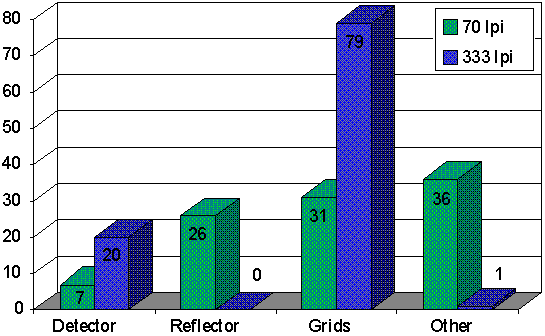
Figure 1. Fate of Ions With 70 and 333 lpi Grids (Reflector With Grids)
Figure 1 compares these results obtained for 70 and 333 line per inch grids (lpi). The sensitivity of the instrument (with grids in the reflector) is approximately 3 times greater when 333 lpi grids are used. The lower transmission of these grids (70%) compared to that of the 70 lpi grids (90%) is compensated for by a reduction in ion scattering as the ions pass through the grids. When ions are scattered by the 70 lpi grids over 62% are given a new trajectory that prevents them from reaching the detector, almost all of the ions simulated in an instrument with 333 lpi grids either strike a grid or reach the detector. This also has a significant impact on resolution. When ions are scattered at two different grid transitions there can be a significant difference in their path length and therefore time-of-flight.
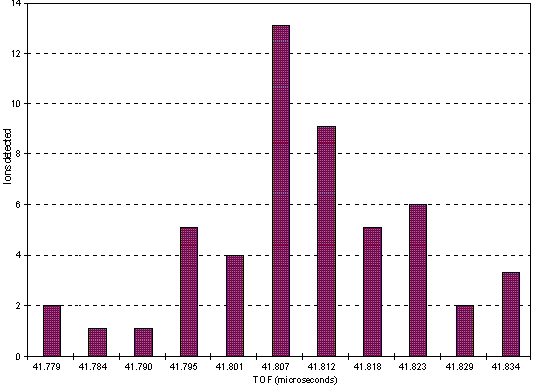
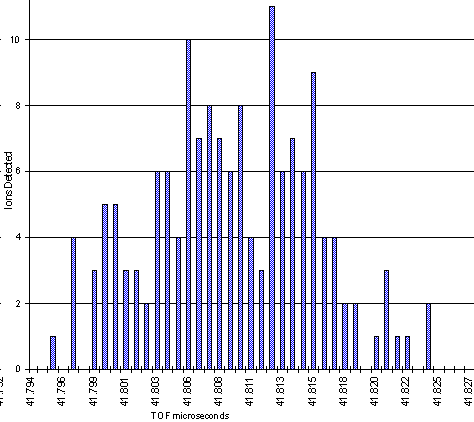
2. Simulated Flight Times: A. 70 lpi; B. 333 lpi
The flight time distributions shown in Figure 2 are entirely due to grid effects. No other effects are included in the simulation.
Simulation:
In this work we examine the effects of grid scattering in a Reflectron TOFMS with a gridless reflector. We have examined this problem for two reasons. First, it was observed that a significant fraction of the grid scattering in our earlier work [2,8] occurred during the 4 transitions ions made through reflector grids. We also noted that many of the ions that reached the detector only did so because there were significantly scattered at two grid transitions. The second event happened to return the ion to a trajectory that terminated at the detector. These ions contributed significantly to the temporal width of the signal at the detector. It should be noted that the gridless reflectors have been commercially available for several years (Brucker).

Figure 3. Simulated Instrument With Gridless Reflector Electrostatic contour lines and an ions trajectory without grid effects are shown.
A three dimensional view of the simulated instrument is shown in Figure 3. The reflector in this instrument was identical to that used in Reference 8, except that the reflector grids have been removed and a ground can has been place around the reflector and part of the drift region. A two stage source and a two stage reflector were used. In the source, the ion was assumed to start at the first electrode and be given 10% of its drift energy in the first stage. Most of the acceleration, therefore, took place in the second stage. Each source region was 12.5 mm long. The ion mirror (or reflector) was positioned 475 mm from the source at an angle of 0.73 degrees from the primary axis of the source (z-axis). The reflector had regions of 12 (front) and 127 mm (back). Within each of these regions the potential along the surface of the reflector varied linearly. The point between the two regions was held at a potential equivalent to 90 % of the drift energy. The back of the reflector was held at a potential 1 % greater than the starting point of the ions in order to turn them back toward the detector. A 20 mm diameter detector was placed 500 mm from the reflector. Each of the instrument elements, source, reflector, and detector, were modeled as a separate instance and placed on the Ion Optics Bench. They were positioned such that, when the effects of grids were not considered, an ion originating from the source would strike the center of the detector. This is illustrated by the ion trajectory shown in Figure 3. A series of equi-potential contours are also shown to illustrate the effect that grid removal had on the electrostatic fields within the reflector. The simulation of a small section of grid occurred in a fourth instance. This instance was modeled with a very high density array of 0.0017 mm between potential array points. The entire instance required over 5 million points. While the grid instance is included in Figure 3, it is too small to be seen on the scale shown. It included nine grid holes and the volume within a distance of 1.5 grid holes on either side of the grid. At that distance, the electric field was assumed to be uniform and a pair of solid electrodes were used to establish the fields in either direction. (See References 3 and 8 for further details.) The simulation involved flying a large number of ions through the instrument. Every time an ion experienced a large change in electric field, a user program was used to "jump" the ion to the grid instance. The ion was placed in a random position just above the plane of one of the solid electrodes. The electrical fields within the grid instance were then adjusted to reflect the fields that the ion had experienced just before it jumped. Thus, the single grid instance could be used to simulate all of the grids within the instrument. Since the ion was placed in a random position along a side of the grid instance, the simulation was able to account for ions passing through different parts of a grid opening. In the current calculation, only the field along the z-axis is considered so it is assumed that grids are normal to this axis.
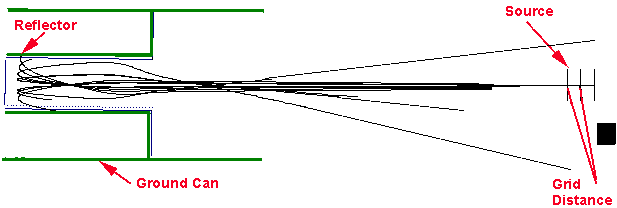
Figure 4. Paths of ions with grid effects.
Results:
Figure 4 shows the paths of several ions with a grid jumping active. Each time the ion encounters a grid, it jumps to a point at the lower right of the figure where the very small grid instance is positioned. After passing through the grid instance, the ion is then placed back in its original position. This occurs once for each of the two grid transitions. The fate of the ions is shown in Figure 5. A very large fraction of the ions missed the detector. It was found that the exact trajectory of the ions entering the reflector was critical to its reaching the detector. This was a result of the strongly diverging electrostatic lens produced by our simple reflector design. It was found, for instance, that the reflector angle had to be within +/- 0.13 degrees for the ion to reach the detector when grid effects were not included. This range was +/- 0.22 degrees when grids were included in the reflector. (It is assumed that modifications to the shapes and potentials of the reflector electrodes would be used to reduce the strength of the diverging lens. However, it is not our current goal to optimize the reflector design. Our purpose is to demonstrate the need for proper simulation and demonstrate a method for doing so.) Use of 333 lpi grids increased the fraction of detected ions by 15 times. This is an even more dramatic result than was found in the simulation of the gridded reflector. It was hoped that the few ions detected would at least represent a narrow range in flight times. However, the detected signals were on the order of 33 ns wide.
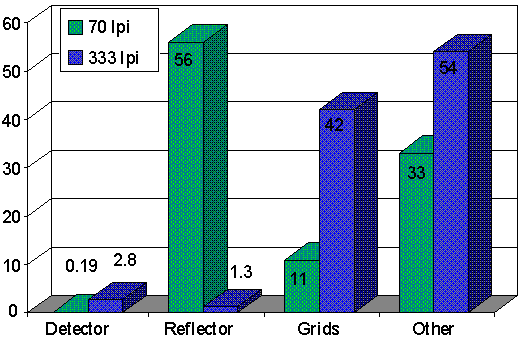
Figure 5. Fate of Ions With Gridless Reflector
Conclusions
Grid scattering is having a dramatic effect on both the sensitivity and resolution of the instrument. This is true even in instrument with gridless reflectors. We have shown the need and a method of simulating these effects. We are currently planning to compare our simulated results with experimental data.
References
1. David A. Dahl 43ed ASMS Conference on Mass Spectrometry and Allied Topics, May 21-26 1995, Atlanta, Georgia, 717.
2. S. M. Colby; C. W. Baker; J. J. Manura Proc, 41st ASMS Conf. 1996. (Available at www.sisweb.com application note #47)
3. X. Tang, R. Beavis, W. Ens, F. Lafortune, B. Schueler and K. G. Standing, Int. J. Mass Spectrom. Ion Processes, 85 (1988) 43.
4. D. Ioanoviciu, Int. J. Mass Spectrom. Ion Processes, 131 (1994) 43.
5. T. Bergmann, T. P. Martin and H. Schaber, Rev. Sci. Instrum., 60 (1989) 347.
6. R. C. King, R. Goldschmidt and K. G. Owens 39th ASMS Conference on Mass Spectrometry and Allied Topics, May 19-24 1994, Nashville, TN, 717.
7. V. V. Laiko and A.F. Dodonov, Rapid Comm. Mass Spectrom. 8 (1994) 720-726. 8. S. M. Colby PittCon97 730, and 1996 Eastern Analytical Symposium.

